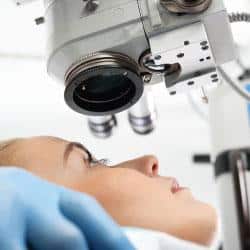
In today’s world, a person has to actively try to avoid regular viewing of some type of technological device’s screen. More than a third of American adults spend more than half of their day with some type of technology and 14% report using technology 10-12 hours daily. The problem goes beyond the adult population. In classrooms 97% of students own a computer at home and 40% of teachers (and growing) integrate digital devices into their teaching.
Even with constant exposure, most people are oblivious to the unpleasant (and sometimes plain scary) effects of prolonged technology use on their eyes. Below we’ll detail some of the things that can and do happen to people’s eyes and bodies when they watch screens the majority of their day, every day.
1. Computer Vision Syndrome
Starring at digital screens – tablet, computer, cellphone, TV, iWatch, Fitbit, car GPS – affects your eyes so seriously that health experts have coined the term, “Computer Vision Syndrome.” Though the term was initially used in the context of office employees who spent hours in front of their computers, today the increased symptoms associated with CVS affect millions around the world regardless of age or occupation. Those can include:
- Eyestrain
- Headaches
- Focusing difficulty
- Itchy, burning, or watery eyes
- Dry eye
- Double vision
- Blurred vision both in distant and nearby objects
- Sensitivity to Light (also called photophobia)
Any of these can be mild or disabling – and natural when the eyes are working so hard. When you glance at electronic devices, a couple of things occur which increase the likelihood of CVS symptoms.
You Blink Less – Normally, the human eye under normal conditions blinks 12-15 times a minute. However, when your brain focuses on a screen, it can make you forget to blink and the count can go down to a mere 7-8 blinks a minute. Every time you blink, you spread a layer of tears over your eyes, so less blinking means your eyes get less lubrication which leads to dry and sore eyes.
You Use Unfavorable Angles – As opposed to reading printed text where you normally look down to read, when starring at a screen the eyes are usually focused straight ahead. When looking down while reading, your eyelid covers more of your eye than when you look straight on. This means looking at a screen angle exposes more of your eye to the air’s drying effects.
This unfavorable lid positioning, together with a reduction in blinking, leaves you with uncomfortably dry eyes and even visual fatigue. Cell phones are changing some of this – but then think of all the careful selfies people take just to get the perfect pic.
You Get Too Close for Comfort – You may have already noticed that when reading on your smartphone, you usually hold it closer to your eyes than you would with traditional printed text. And you are not the only one.
A 2011 study found that nearly all their subjects placed their phones 12.5-14 inches from their eyes to read mobile text while the average distance for printed text is nearly 16 inches. This means that your eyes are forced to work harder to focus at close ranges by having to almost turn cross-eyed, which tires out the eyes.
2. Retina Damage
If you do not carry your phone or laptop with you when you go to bed, you are in the minority. Almost 60% of adult Americans have adopted this habit and replaced their alarm clocks with digital technology. This habit however, can cause significant damage to your eyes.
According to the American Macular Degeneration Foundation, direct exposure to the blue light emitted by LED devices can really damage the retina. The retinal damage that occurs from starring at the blue light – especially at night – can lead to macular degeneration and damage your central vision (the ability to see things right in front of you).
As you age, this becomes even more important, and your retina becomes more sensitive to damage, which can often leave you with additional age-related macular degeneration.
3. Possible Cataracts
Although more research is needed when it comes to the link between cataracts and blue light, doctors are beginning to observe patients in their mid-30s with eyes as cloudy from cataracts as people in their mid-70s. To be clear, this is not definitive proof that exposure to blue light causes cataracts, but there might be a link that deserves further investigation.
4. Eye-related Issues: Headaches
Headaches are the third most common negative effect of your eye’s overexposure to digital devices.
When you stare at a screen for too long, the eyestrain that occurs often results in tension headaches. This is because the darkness of the text, contrasted against the bright screen, makes your eyes work harder to focus and results in muscle spasms at the temples.
It is undisputable that technology makes our lives easier, more efficient and most of the time, more enjoyable. But given the side effects of overexposure to smartphones, tablets, laptops, and other LED-emitting devices on your eyes, it is important to take a step away from electronics every once in a while.
Doing simple things such as adjusting the brightness of your devices and the distances at which you view them can decrease your chances of suffering from eyestrain, dry eyes, sensitivity to light, and even retina damage and possible cataracts. Our site is called Good Eyes for a reason. Barnet Dulaney Perkins Eye Center is there for maintaining your overall eye health, as well for LASIK or cataract surgery.
Use technology wisely, and your eyes will thank you. Yes, we realize the irony of reading this on a website.


